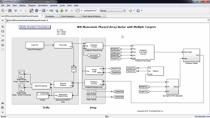Modeling Radar and Wireless Coexistence
Congestion in the radio frequency (RF) spectrum and increasing demand for RF bandwidth has resulted in sharing the spectrum between different RF users, including radar systems and wireless communication systems. The coexistence between radar and communication systems generates some unwanted effects such as interference or blockage. By understanding these effects, proper mitigation techniques can be developed to ensure satisfactory performance of the two systems.
See how to model a scenario with a radar system and a wireless communication system working in the same environment and using the same spectrum. Assess the possible radar performance degradation and evaluate different mitigation techniques.
Learn how to:
- Model a radar system in the vicinity of a wireless communication system, including RF and antenna subsystems, waveform designs, and a realistic propagation environment
- ·Generate IQ signal at the radar receiver due to the target reflection and broadcasted wireless communication signal
- ·Sense and identify received waveforms; apply beamforming techniques to avoid or minimize interference effects
Published: 31 May 2022




